Foreword
How to read this book
History of Nigiri sushi
Classification of Nigiri sushi
1.AKAMI
1-1 Pacific bluefin tuna (Taiheiyou Kuro maguro)
1-1-1 Lean meat of tuna (Akami)
1-1-2 Medium Fatty Tuna (Chutoro)
1-1-3 Very Fatty Tuna (Otoro)
What is Harakami Ichiban?
1-1-4 Meji-maguro
1-1-5 Hachinomi
1-1-6 Kamatoro
1-1-7 Jabara
1-1-8 Chiai-gishi
1-1-9 Wakaremi
What is Hagashi?
1-1-10 Tossaki
1-1-11 Tenpa
1-1-12 Hohoniku
1-1-13 Sunazuri
1-2 Atlantic bluefin tuna (Taiseiyou Kuro maguro)
1-3 Southern bluefin tuna (Minami maguro)
1-4 Bigeye tuna (Mebachi maguro)
1-5 Yellowfin tuna (Kihada maguro)
1-6 Albacore Tuna (Binnaga maguro)
What are Meji, Chubou and Maguro?
1-7 Bonito (Katsuo)
1-8 Striped marlin (Makajiki)
The history of how toro sushi became a superstar!
2.SHIROMI
2-1 Atlantic salmon
2-2 Salmon trout
What is Toro salmon?
2-3 King salmon (Masunosuke)
2-4 Chum salmon (Tokishirazu)
2-5 Chum salmon (Keiji)
2-6 Cherry salmon (Sakuramasu)
Salmon is not used as a topping in Edomae sushi!
2-7 White horsehead (Shiro-amadai)
2-8 Horsehead (Aka-amadai)
2-9 Largehead hairtail (Tachiuo)
2-10 Large-eyed bream (Meichidai)
2-11 Splendid alfonsino (Kinmedai)
2-12 Red seabream (Madai)
What is Red Snapper the same as “Tai”?
2-13 Bastard halibut (Hirame)
2-14 Engawa
2-15 Marbled sole (Makogarei)
2-16 Spotted halibut (Hoshigarei)
How to tell the difference Between Buri, Hiramasa and Kanpachi
2-17 Greater amberjack (Kanpachi)
2-18 Japanese amberjack (Buri)
2-19 Young amberjack (Inada)
2-20 Goldstriped amberjack (Hiramasa)
2-21 Striped jack (Shima aji)
2-22 Japanese spanish mackerel (Sawara)
2-23 Japanese sea bass (Suzuki)
2-24 Chicken grunt (Isaki)
2-25 Filefish (Kawahagi)
When does Kinmedai taste the best?
2-26 Blackthroat seaperch (Nodoguro)
2-27 Tiger puffer (Torafugu)
2-28 Red spotted grouper (Kijihata)
2-29 Bartail flathead (Kochi)
2-30 Sevenband grouper (Hata)
What is Wasabi?
2-31 Longtooth grouper (Kue)
2-32 Japanese butterfish (Ebodai)
2-33 Red gurnard (Houbou)
2-34 Devil stinger (Okoze)
2-35 Green ling (Ainame)
2-36 Red barracuda (Kamasu)
How to use soy sauce under the watchful eye of a Sushi chef
2-37 Barred knifejaw (Ishidai)
2-38 Alaska codfish (Madara)
2-39 Black rockfish (Kurosoi)
2-40 Black seabream (Kurodai)
2-41 Bighand thornyhead (Kichiji)
2-42 Japanese bluefish (Mutsu)
How to Jukusei?
3.HIKARIMONO
3-1 Mackerel (Saba)
3-2 Horse mackerel (Aji)
3-3 Japanese sardine (Iwashi)
3-4 Japanese halfbeak (Sayori)
What is Tsukedai?
3-5 Pacific saury (Sanma)
3-6 Gizzard shad (Kohada)
3-7 Baby Gizzard shad (Shinko)
3-8 Young crimson sea bream (Kasugo)
3-9 Japanese whiting (Kisu)
3-10 Pacific herring (Nishin)
What are Uwami and Shitami?
4.NIMONO
4-1 Common orient clam (Nihamaguri)
4-2 Japanese conger (Anago)
4-3 Japanese eel (Unagi)
4-4 Squilla (Shako)
4-5 Japanese icefish (Shirauo)
Does the taste of wasabi differ depending on the grater?!
5.KAI
5-1 Ark shell (Akagai)
5-2 Japanese abalone (Kuro awabi)
5-3 Giant abalone (Madaka awabi)
5-4 Disk abalone (Megai awabi)
5-5 Ezo abalone (Ezo awabi)
5-6 Japanese egg cockle (Torigai)
5-7 Common scallop (Hotate)
What is Tezu?
5-8 Sakhalin surf clam (Hokkigai)
5-9 Japanese oyster (Kaki)
5-10 Keen’s gaper (Mirugai)
5-11 Round clam (Aoyagi)
5-12 Round clam ligaments (Kobashira)
5-13 Pen-shell (Tairagi)
5-14 Whelk (Tsubugai)
Why is sushi served with Gari?
Types of squid
6.IKA/TAKO
6-1 Bigfin reef squid (Aori ika)
6-2 Golden cuttlefish (Sumi ika)
6-3 Swordtip squid (Kensaki ika)
6-4 Spear squid (Yari ika)
Why is Nigiri sushi eaten with soy sauce?
6-5 Japanese common squid (Surume ika)
6-6 Baby Golden cuttlefish (Shin ika)
6-7 Firefly squid (Hotaru ika)
6-8 North pacific giant octopus (Mizudako)
6-9 Common octopus (Madako)
What is Sute-shari?
7.EBI/KANI
7-1 Kuruma prawn (Kuruma ebi)
7-2 Botan shrimp (Botan ebi)
7-3 Morotoge shrimp (Shima ebi)
7-4 Sweet shrimp (Ama ebi)
Learn the basics of pairing sake with sushi!
7-5 Broad velvet shrimp (Shiro ebi)
7-6 Snow crab (Zuwaigani)
7-7 Horsehair crab (Kegani)
Why did the vinegar used in shari switch from red vinegar to rice vinegar?
8.GYORAN
8-1 Salmon roe (Ikura)
8-2 Herring roe (kazunoko)
8-3 Green sea urchin (Bafun uni)
8-4 Red sea urchin (Aka uni)
Why is it that sea urchin sushi can taste bitter?
8-5 Purple sea urchin (Murasaki uni)
8-6 Short-spined sea urchin (Ezobafun uni)
Hokkaido’s main Ezobafun uni production area
8-7 Northern sea urchin (Kitamurasaki uni)
Hokkaido’s main Kitamurasaki uni production area
8-8 Herring spawn on kelp (Komochi kombu)
The secret story of how Ikura became a sushi topping!
9.OTHERS
9-1 Young Green Onion Shoots (Menegi)
9-2 Shiitake mushroom (Shiitake)
9-3 Daggertooth pike conger (Hamo)
What tea pairs well with Nigiri sushi?
9-4 Oboro
9-5 Monkfish liver (Ankimo)
9-6 Milt (Shirako)
9-7 Omelette (Tamagoyaki)
Does real Edomae sushi no longer exist!?
10.MAKIMONO
10-1 Dried Gourd Shavings Sushi Roll (Kanpyo maki)
What is Kanpyo?
10-2 Tuna Roll (Tekka maki)
10-3 Cucumber roll (Kappa maki)
What is Okonomi?
Sushi Restaurant Etiquette
Sushi Vocabulary and Jargon
Afterword
References
Cooperating sushi restaurant for photography
Copyright
 Buy now
Buy now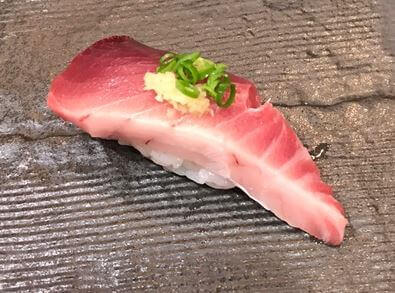 Toro is an absolute at sushi restaurants and it’s only natural to aspire to such a position. That’s why there are so many sushi dish names that start with “Toro”. The most laissez-faire of these is Toro salmon. In this case the definition of Toro is ignored in an attempt to promote sales. Just as bad is Toro katsuo (pronounced “Toro-gatsuo” in Japanese).
Toro is an absolute at sushi restaurants and it’s only natural to aspire to such a position. That’s why there are so many sushi dish names that start with “Toro”. The most laissez-faire of these is Toro salmon. In this case the definition of Toro is ignored in an attempt to promote sales. Just as bad is Toro katsuo (pronounced “Toro-gatsuo” in Japanese).
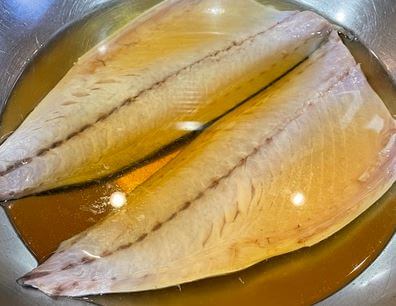
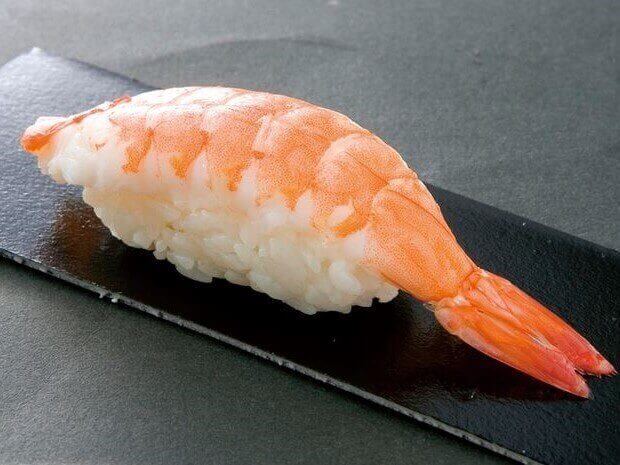 Japan leads the world in shrimp consumption by far. Most of the shrimp is imported, but it is a little known fact that shrimp is called “Meki” among importers and sushi restaurants in Japan. It is said to be a remnant from a time when much of the imported shrimp came from Mexico (pronounced “Mekishiko” in Japanese).
Japan leads the world in shrimp consumption by far. Most of the shrimp is imported, but it is a little known fact that shrimp is called “Meki” among importers and sushi restaurants in Japan. It is said to be a remnant from a time when much of the imported shrimp came from Mexico (pronounced “Mekishiko” in Japanese).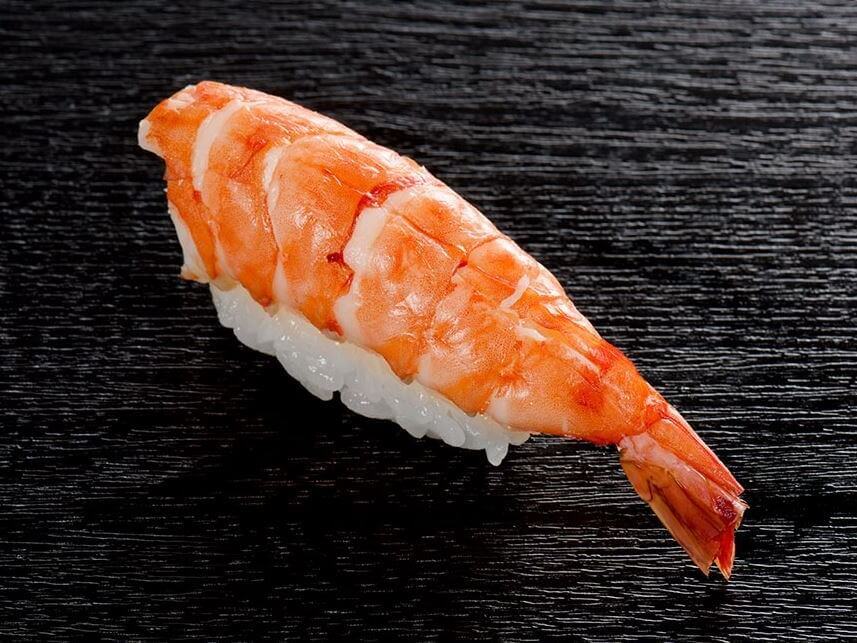
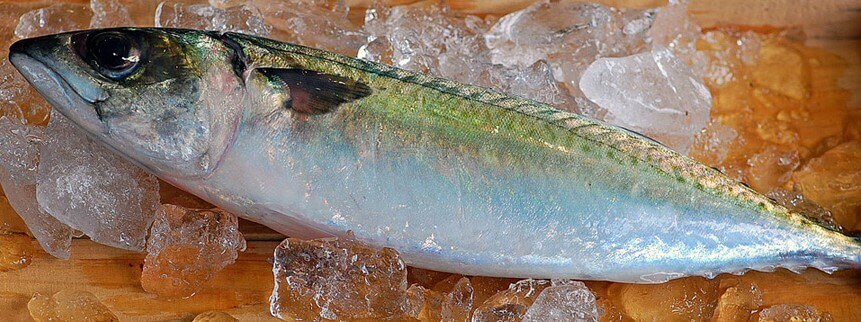
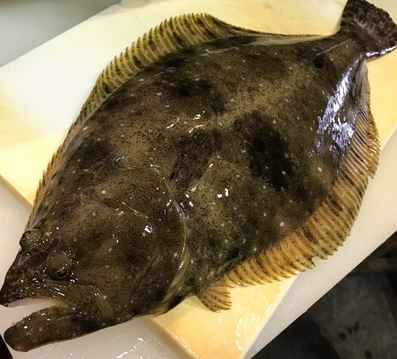 Hirame is a high-quality fish that goes for at least US $50 per kilogram. It can even exceed US $80 per kilogram, depending on the timing and the fish’s body.
Hirame is a high-quality fish that goes for at least US $50 per kilogram. It can even exceed US $80 per kilogram, depending on the timing and the fish’s body.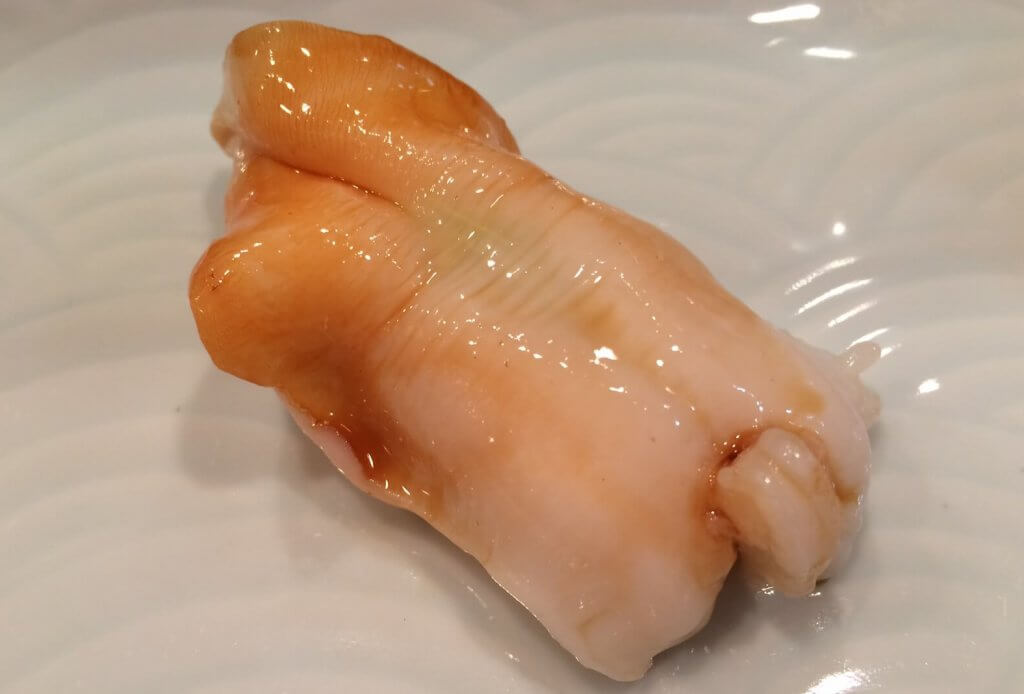 Ishigakigai is a shellfish found from Kashimanada northward, Hokkaido, from the Kuril Islands to the Aleutian Islands and even on the west coast of North America. It lives off of plankton in the shallow sandy mud bottoms of the sea at depths of about 50 meters.
Ishigakigai is a shellfish found from Kashimanada northward, Hokkaido, from the Kuril Islands to the Aleutian Islands and even on the west coast of North America. It lives off of plankton in the shallow sandy mud bottoms of the sea at depths of about 50 meters.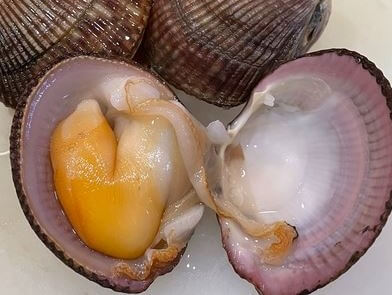 It starts to become common at the market when the Japanese rainy season ends, at the beginning of summer every year, which is around the end of the Torigai season. It then disappears from the market at the end of summer. A number of sushi restaurants start using it as a substitute for Torigai all at the same time, so Ishigakigai nigiri sushi suddenly started appearing on menus. Frankly, it is somewhat conservative as a nigiri topping but is known for the crunchy texture when biting into it. It also has strong sweetness and umami, which goes exquisitely with Shari. The sushi chef slaps the meat in his hand directly before serving to stiffen it–a way to increase the crunchy texture characteristic of shellfish. Naturally this texture is evidence of its freshness.
It starts to become common at the market when the Japanese rainy season ends, at the beginning of summer every year, which is around the end of the Torigai season. It then disappears from the market at the end of summer. A number of sushi restaurants start using it as a substitute for Torigai all at the same time, so Ishigakigai nigiri sushi suddenly started appearing on menus. Frankly, it is somewhat conservative as a nigiri topping but is known for the crunchy texture when biting into it. It also has strong sweetness and umami, which goes exquisitely with Shari. The sushi chef slaps the meat in his hand directly before serving to stiffen it–a way to increase the crunchy texture characteristic of shellfish. Naturally this texture is evidence of its freshness.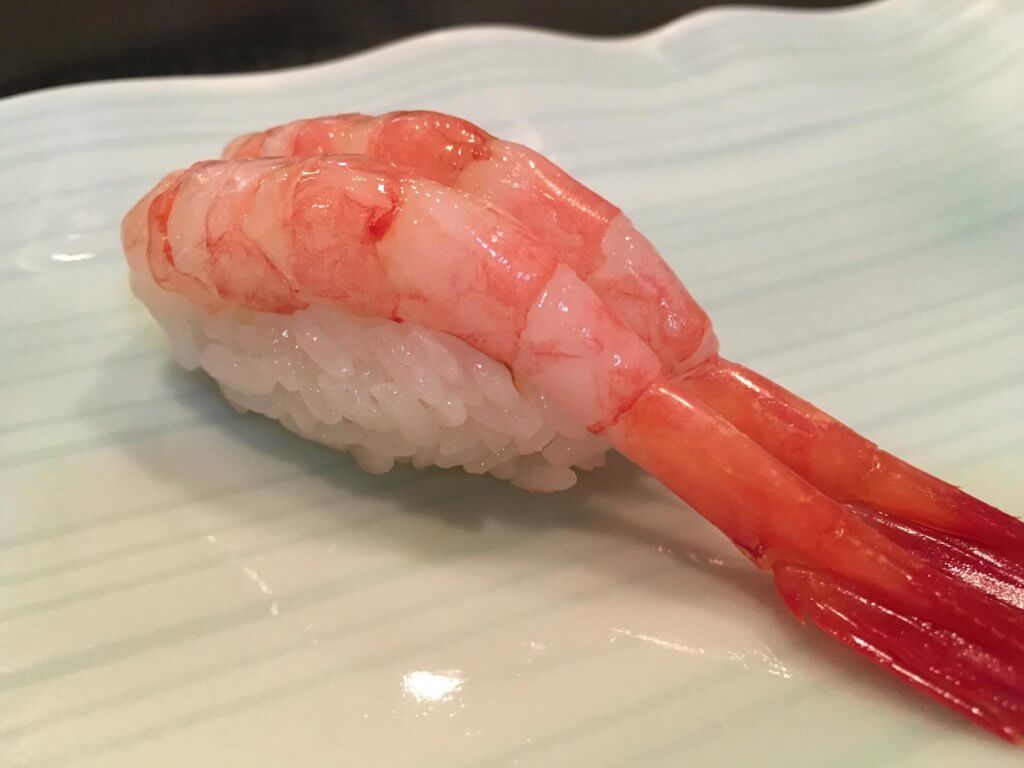 It goes without saying, that each type of fish has its very own scientific name. However, in places like the Toyosu Fish Market, there are seafoods that end up sharing a name.
It goes without saying, that each type of fish has its very own scientific name. However, in places like the Toyosu Fish Market, there are seafoods that end up sharing a name.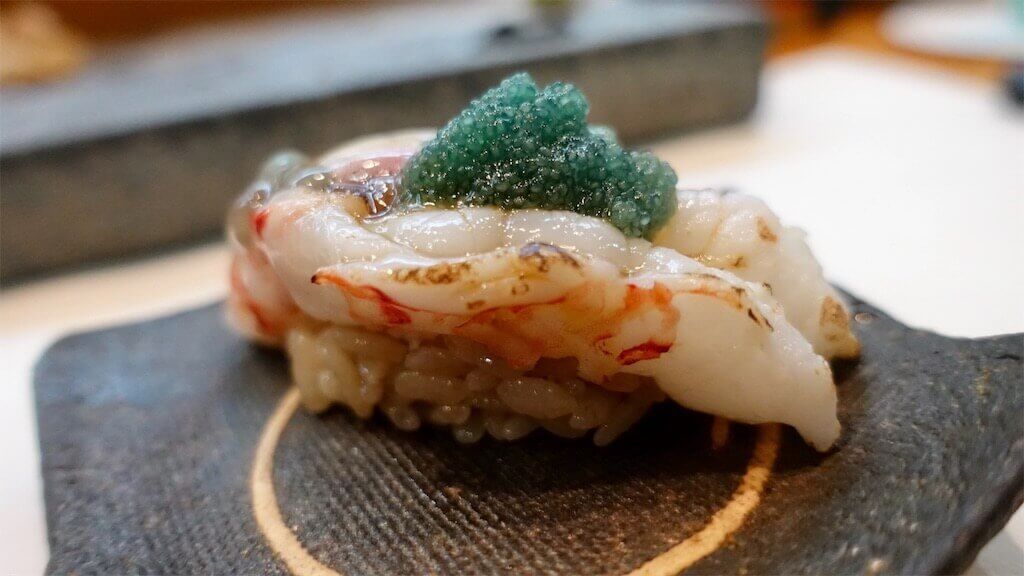 One type of shrimp that is used for nigiri sushi when still raw is Botan ebi. Needless to say, it is an extremely new addition to the Edomae sushi topping list. Interestingly, there are two types of domestic shrimp that are called Botan ebi in the Toyosu Market.
One type of shrimp that is used for nigiri sushi when still raw is Botan ebi. Needless to say, it is an extremely new addition to the Edomae sushi topping list. Interestingly, there are two types of domestic shrimp that are called Botan ebi in the Toyosu Market.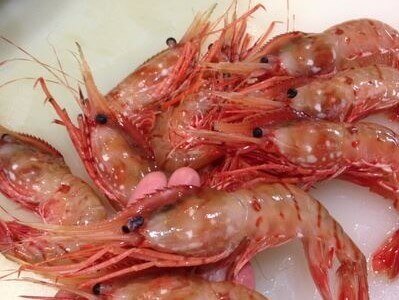 One is called by its Japanese name, Toyama ebi, with a length of 25 cm, lives in the sea at depths of 100 to 400 m, and is normally caught in Funka Bay of Hokkaido on the Japan Sea side. It actually isn’t caught in Toyama very often despite being called Toyama ebi. At the cheapest it still costs US $20 per kilogram, and in rare cases can exceed $200 per kilogram. In the Toyosu Market, it is called “Torabotan” because of the tiger stripes on the shell (“Tora” is Japanese for tiger).
One is called by its Japanese name, Toyama ebi, with a length of 25 cm, lives in the sea at depths of 100 to 400 m, and is normally caught in Funka Bay of Hokkaido on the Japan Sea side. It actually isn’t caught in Toyama very often despite being called Toyama ebi. At the cheapest it still costs US $20 per kilogram, and in rare cases can exceed $200 per kilogram. In the Toyosu Market, it is called “Torabotan” because of the tiger stripes on the shell (“Tora” is Japanese for tiger).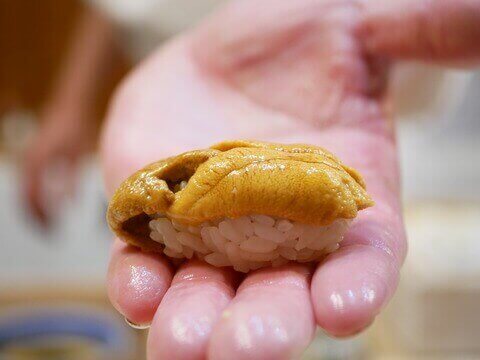 In Japanese, when a compound word is made out of two individual words, and the first consonant of the second word changes from a “clear sound” to a “fuzzy sound”, it is called “Rendaku”. For example, Edomae (江戸前) + sushi (寿司) changes to Edomaezushi (江戸前寿司). However, the correct pronunciation is only generalized among Japanese people, so in this book we chose the most commonly searched version of each compound word.
In Japanese, when a compound word is made out of two individual words, and the first consonant of the second word changes from a “clear sound” to a “fuzzy sound”, it is called “Rendaku”. For example, Edomae (江戸前) + sushi (寿司) changes to Edomaezushi (江戸前寿司). However, the correct pronunciation is only generalized among Japanese people, so in this book we chose the most commonly searched version of each compound word.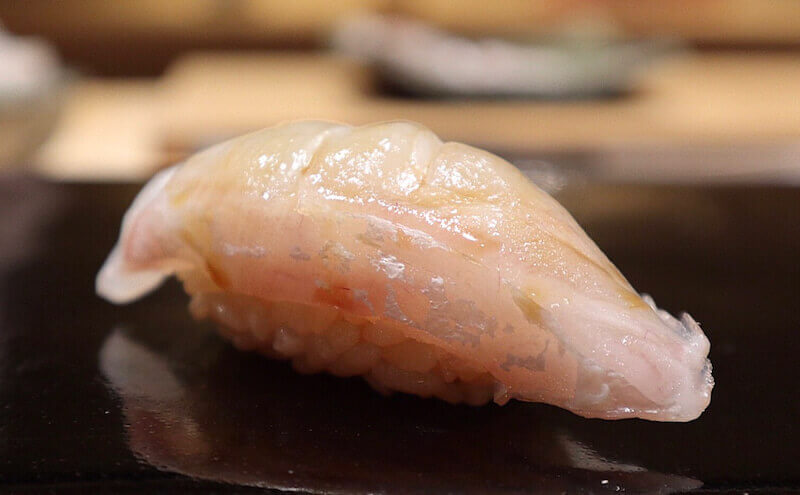 Out of the five types of Amadai that live in Japan, Aka-amadai, Shiro-amadai and Ki-amadai are the three types offered in the markets.
Out of the five types of Amadai that live in Japan, Aka-amadai, Shiro-amadai and Ki-amadai are the three types offered in the markets.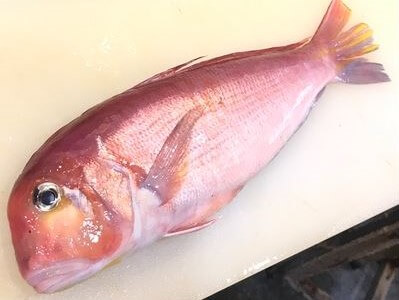 The main characteristics of Aka-amadai are its overall red body, the bright yellow color under the eyes and how part of its fin is a shiny cobalt blue color. Aka-amadai is called “
The main characteristics of Aka-amadai are its overall red body, the bright yellow color under the eyes and how part of its fin is a shiny cobalt blue color. Aka-amadai is called “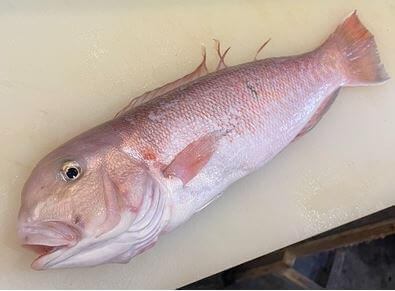 Shirakawa is considered to be the finest of the Amadai and can cost more than US $100 per kilogram. Aka-amadai costs around US $40 per kilogram. Shirakawa always ranks in the top three fish for market price. Shirakawa has more elasticity than the other two and has rich fat, making it perfect as sashimi or a sushi topping. The umami is so strong that even when served raw, the customer sometimes thinks it’s been prepared using kobujime. The fat between the meat and the skin is sweet and the skin is delicious in its own right, so it can even be eaten as sashimi with the skin left on. The famous production sites include Tsushima in Nagasaki Prefecture and Yawatahama in Ehime Prefecture. They are in season from autumn to winter. However, they say in a catch of 1,000 Amadai, you can only get one Shirakawa, so it is a rare item you won’t often see, even in a high-end sushi restaurant.
Shirakawa is considered to be the finest of the Amadai and can cost more than US $100 per kilogram. Aka-amadai costs around US $40 per kilogram. Shirakawa always ranks in the top three fish for market price. Shirakawa has more elasticity than the other two and has rich fat, making it perfect as sashimi or a sushi topping. The umami is so strong that even when served raw, the customer sometimes thinks it’s been prepared using kobujime. The fat between the meat and the skin is sweet and the skin is delicious in its own right, so it can even be eaten as sashimi with the skin left on. The famous production sites include Tsushima in Nagasaki Prefecture and Yawatahama in Ehime Prefecture. They are in season from autumn to winter. However, they say in a catch of 1,000 Amadai, you can only get one Shirakawa, so it is a rare item you won’t often see, even in a high-end sushi restaurant.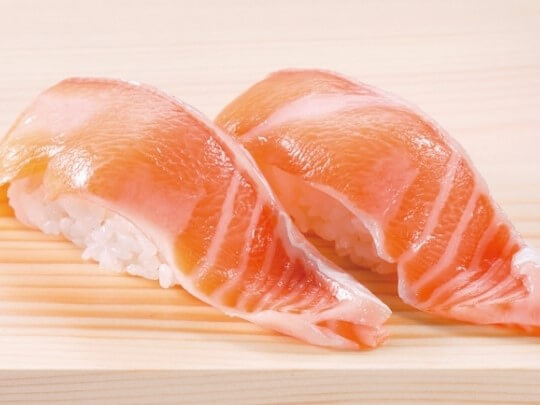 You probably already know this, but “toro tuna” is not the name of a type of fish. “Toro” is the name of a fatty part of the tuna. The fat content and attributes of the belly side of the tuna are completely different from that of the dorsal side. Toro is the name of the part near the head, mostly on the belly side.
You probably already know this, but “toro tuna” is not the name of a type of fish. “Toro” is the name of a fatty part of the tuna. The fat content and attributes of the belly side of the tuna are completely different from that of the dorsal side. Toro is the name of the part near the head, mostly on the belly side.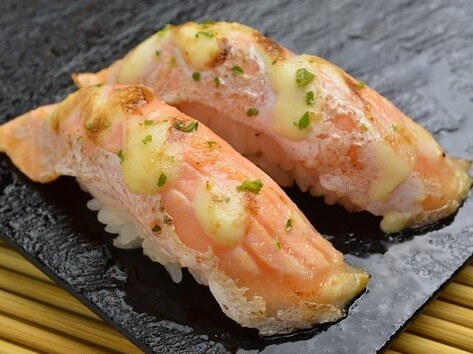 The Donaldson trout is farmed throughout Japan and is used as toro salmon and aburi salmon at conveyor belt sushi restaurants. Since they are supplied directly to the processor (of the salmon) from the farmer without going through the market, they may be sold cheaper than the import price. Just like the imported salmon, this farmed salmon is also fed artificial coloring. There are also already new variants improved from the Donaldson trout being bred. Trout made from breeding Donaldson trout females and steelhead males are called Donaldson steelhead, for instance. They grow even faster.
The Donaldson trout is farmed throughout Japan and is used as toro salmon and aburi salmon at conveyor belt sushi restaurants. Since they are supplied directly to the processor (of the salmon) from the farmer without going through the market, they may be sold cheaper than the import price. Just like the imported salmon, this farmed salmon is also fed artificial coloring. There are also already new variants improved from the Donaldson trout being bred. Trout made from breeding Donaldson trout females and steelhead males are called Donaldson steelhead, for instance. They grow even faster. When you put food in your mouth, the components that are dissolved by your saliva are called extract components. Extract components include mainly free amino acid and inosinic acid as well as organic-based components such as adenosine triphosphate-related substances, creatine and trimethylamine oxide. Extract components are important components that make up the flavor of foods.
When you put food in your mouth, the components that are dissolved by your saliva are called extract components. Extract components include mainly free amino acid and inosinic acid as well as organic-based components such as adenosine triphosphate-related substances, creatine and trimethylamine oxide. Extract components are important components that make up the flavor of foods. First, let’s roughly categorize sake. The two main indicators that determine category are aroma and intensity. Is the aroma fragrant or mild? Is the taste mellow or sharp? This creates 4 categories, fruity (aromatic with a mellow flavor), light (mild aroma with a mellow flavor), umakuchi (mild aroma with a strong flavor) and matured (aromatic with a strong flavor).
First, let’s roughly categorize sake. The two main indicators that determine category are aroma and intensity. Is the aroma fragrant or mild? Is the taste mellow or sharp? This creates 4 categories, fruity (aromatic with a mellow flavor), light (mild aroma with a mellow flavor), umakuchi (mild aroma with a strong flavor) and matured (aromatic with a strong flavor).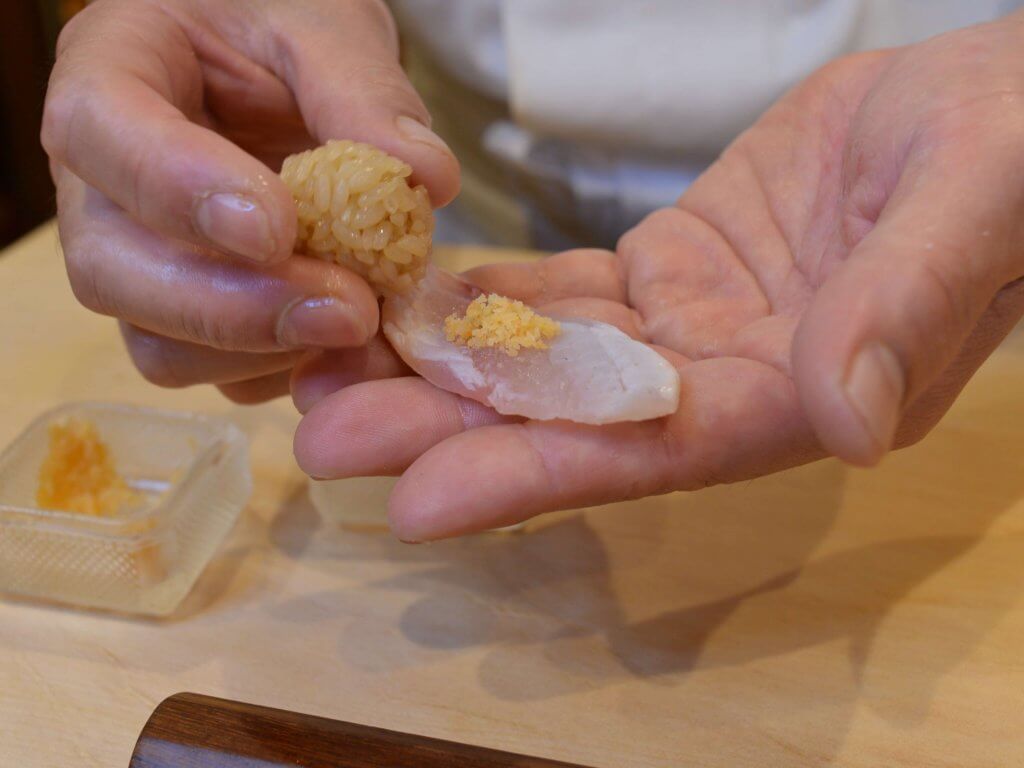 Oboro and Denbu look the same, and the ingredients are also pretty much the same. In other words, there are no clear differences between them, but what it is called differs depending on the restaurant’s policy and the locality. There are various theories for this, but there is no clear line distinguishing oboro and denbu.
Oboro and Denbu look the same, and the ingredients are also pretty much the same. In other words, there are no clear differences between them, but what it is called differs depending on the restaurant’s policy and the locality. There are various theories for this, but there is no clear line distinguishing oboro and denbu.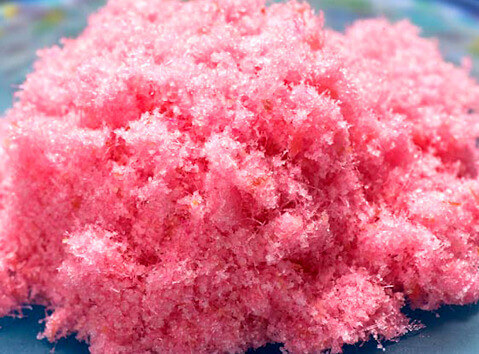 Denbu (田麩) is mainly boiled white fish that is then loosened and made into fibers, then seasoned with sugar, mirin, salt, etc., then roasted until the moisture is gone. Some are colored with red food coloring (called sakura denbu) while others are left as the brown color similar to tsukudani. The appearance is as if only the fibers of the original ingredients remain. This is why it was written with the kanji “田夫” (the literal meaning of kanji: rice patty+husband). The word “田夫” means “someone from the countryside” or “rough-cut” and refers to the way the fish is turned into a coarse form by pulling the meat apart. It is also used as a coloring for chirashizushi, futomaki (large sushi rolls), bento boxes, etc.
Denbu (田麩) is mainly boiled white fish that is then loosened and made into fibers, then seasoned with sugar, mirin, salt, etc., then roasted until the moisture is gone. Some are colored with red food coloring (called sakura denbu) while others are left as the brown color similar to tsukudani. The appearance is as if only the fibers of the original ingredients remain. This is why it was written with the kanji “田夫” (the literal meaning of kanji: rice patty+husband). The word “田夫” means “someone from the countryside” or “rough-cut” and refers to the way the fish is turned into a coarse form by pulling the meat apart. It is also used as a coloring for chirashizushi, futomaki (large sushi rolls), bento boxes, etc.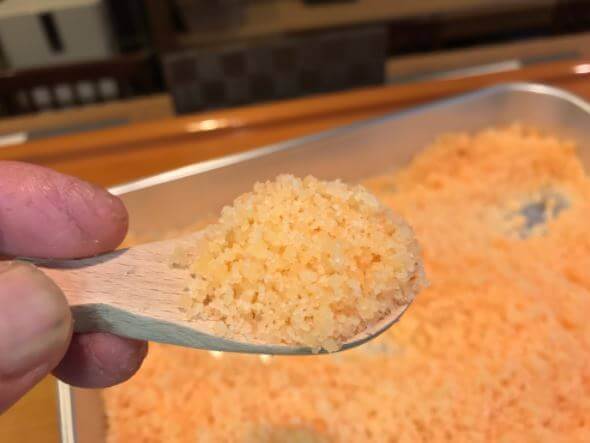 On the other hand, Oboro (朧) is made by using a grinding bowl to break down the meat of shiba shrimp or white fish, then seasoning with sugar, mirin and salt before removing the moisture over low heat. Oboro is used for bara-chirashi, futomaki (large sushi rolls), etc., and is also sometimes used between the topping and shari (vinegared rice) in nigiri sushi. This gentle sweetness and the shrimp aroma are essential for Edo-style sushi. Making oboro is laborious work, so there are fewer and fewer Edo-style sushi restaurants that make their own oboro.
On the other hand, Oboro (朧) is made by using a grinding bowl to break down the meat of shiba shrimp or white fish, then seasoning with sugar, mirin and salt before removing the moisture over low heat. Oboro is used for bara-chirashi, futomaki (large sushi rolls), etc., and is also sometimes used between the topping and shari (vinegared rice) in nigiri sushi. This gentle sweetness and the shrimp aroma are essential for Edo-style sushi. Making oboro is laborious work, so there are fewer and fewer Edo-style sushi restaurants that make their own oboro.